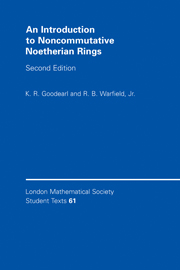Book contents
- Frontmatter
- Contents
- Introduction to the Second Edition
- Introduction to the First Edition
- Prologue
- 1 A Few Noetherian Rings
- 2 Skew Polynomial Rings
- 3 Prime Ideals
- 4 Semisimple Modules, Artinian Modules, and Torsionfree Modules
- 5 Injective Hulls
- 6 Semisimple Rings of Fractions
- 7 Modules over Semiprime Goldie Rings
- 8 Bimodules and Affiliated Prime Ideals
- 9 Fully Bounded Rings
- 10 Rings and Modules of Fractions
- 11 Artinian Quotient Rings
- 12 Links Between Prime Ideals
- 13 The Artin-Rees Property
- 14 Rings Satisfying the Second Layer Condition
- 15 Krull Dimension
- 16 Numbers of Generators of Modules
- 17 Transcendental Division Algebras
- Appendix. Some Test Problems for Noetherian Rings
- Bibliography
- Index
2 - Skew Polynomial Rings
Published online by Cambridge University Press: 11 November 2010
- Frontmatter
- Contents
- Introduction to the Second Edition
- Introduction to the First Edition
- Prologue
- 1 A Few Noetherian Rings
- 2 Skew Polynomial Rings
- 3 Prime Ideals
- 4 Semisimple Modules, Artinian Modules, and Torsionfree Modules
- 5 Injective Hulls
- 6 Semisimple Rings of Fractions
- 7 Modules over Semiprime Goldie Rings
- 8 Bimodules and Affiliated Prime Ideals
- 9 Fully Bounded Rings
- 10 Rings and Modules of Fractions
- 11 Artinian Quotient Rings
- 12 Links Between Prime Ideals
- 13 The Artin-Rees Property
- 14 Rings Satisfying the Second Layer Condition
- 15 Krull Dimension
- 16 Numbers of Generators of Modules
- 17 Transcendental Division Algebras
- Appendix. Some Test Problems for Noetherian Rings
- Bibliography
- Index
Summary
We continue the study of skew polynomial rings in this chapter, first discussing the case where the multiplication is twisted by a derivation, and then developing the general case. Since our main motivation for looking at skew polynomial rings is to be able to construct and work with further important examples of noetherian rings, most of the later part of the book could be read independently of this chapter. Readers who are interested in immediately getting into the general theory of noetherian rings should feel free to skip to Chapter 3 and return to this chapter later.
• FORMAL DIFFERENTIAL OPERATOR RINGS •
Several of the examples discussed in the Prologue appear as polynomial rings in which multiplication by the indeterminate is twisted by a derivation rather than by an automorphism. This situation has several new features – in particular, the characteristic of the ring plays an important role – but it is still significantly simpler than the general case, in which both an automorphism and a derivation act. Thus, we begin the chapter by studying the derivation case. Since many of the results in this section are parallel to ones in Chapter 1 and will be special cases of later results for general skew polynomial rings, we leave most of the proofs as exercises.
Information
- Type
- Chapter
- Information
- An Introduction to Noncommutative Noetherian Rings , pp. 26 - 46Publisher: Cambridge University PressPrint publication year: 2004
